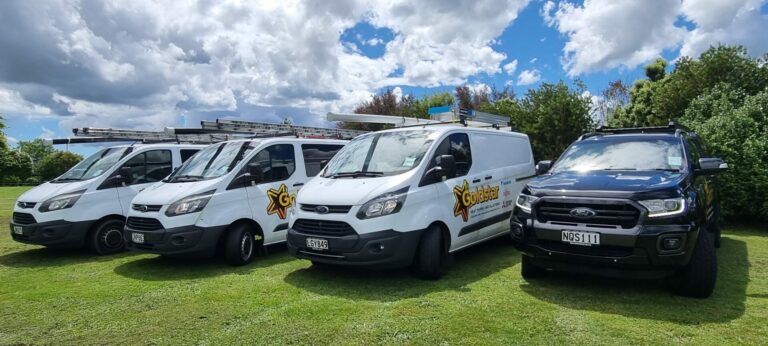One of our suggestions from our article on things to do in Tauranga is to visit the classic Flyers Museum. Before you go and have a look at it we recommend you read this article to give you a little bit of background to the planes you are likely to see while you are there.
As you stand in the air-conditioned building, spare a thought to the pilots who flew these planes without air conditioning or heating inside of them.
CT-4B Airtrainer
The CT-4B Airtrainer, manufactured by Pacific Aerospace Corporation, is a versatile military training aircraft with a robust design. Originating from the Australian-designed Victa Aircruiser, the CT-4 series, particularly the CT-4B, has been adapted for military training purposes. The aircraft features a conventional low-wing monoplane design with a T-tail configuration. Emphasising durability to meet the demanding requirements of military pilot training.
The tandem seating arrangement in the CT-4B allows for effective communication between the instructor and trainee. Making it suitable for various training tasks. It is powered by a Lycoming AEIO-540-L1B5D engine, providing 300 horsepower and facilitating training maneuvers, including aerobatics. With a cruising speed of approximately 143 knots and a range of around 540 nautical miles. The CT-4B is well-suited for both basic and advanced training missions without frequent refuelling.
Uses
The CT-4B covers a broad spectrum of training tasks, including basic flight maneuvers, instrument flying, navigation exercises, and aerobatics. Its capabilities make it an attractive choice for air forces worldwide. Its straightforward design and cost-effectiveness contribute to its popularity in military pilot training programs.
Various air forces globally have utilized the CT-4B Airtrainer for military pilot training. Recognizing its reliability and effectiveness as a training platform. Over time, there may have been upgrades or modifications to the original CT-4B design. Different operators may even have specific variants tailored to their requirements.
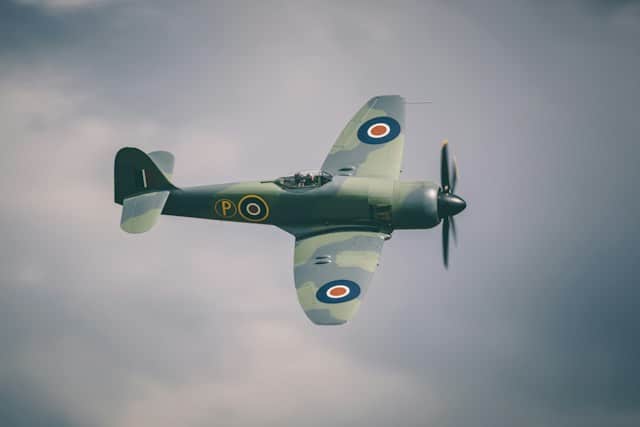
MKV Spitfire
As for the “MkV Spitfire,” it refers to the Supermarine Spitfire Mark V. A renowned British single-seat fighter aircraft from World War II. Developed as an evolution of earlier Spitfire models, the Mk V played a crucial role in the defense of Britain during the Battle of Britain. It featured the classic Spitfire design elements, including elliptical wings and a sleek fuselage.
Armed with a combination of machine guns and cannons, the Spitfire MkV had a Rolls-Royce Merlin engine, contributing to its exceptional speed and climb rate. With improved performance over its predecessors, it served various roles, such as air superiority, ground attack, and photo-reconnaissance. The MkV was deployed in the North African and Mediterranean theatres and played a significant role on the Eastern Front.
The Spitfire MkV had several variants with different armament configurations and specialized roles. Its legacy is celebrated for its contributions to the Allied victory in World War II. Particularly during the Battle of Britain. Many Spitfires, including the Mk V, have been preserved and continue to participate in airshows and commemorations. Showcasing the enduring significance of this iconic aircraft.
North American AT-6 Texan
The North American AT-6 Texan, known as the Harvard in the Commonwealth Air Force. This played a pivotal role in military pilot training during and after World War II. Developed by North American Aviation, it served as an advanced trainer with tandem seating for instructors and trainees. Powered by a Pratt & Whitney radial engine, it demonstrated reliability and adaptability. This led to its widespread use by Allied air forces. The AT-6 Texan/Harvard, featuring various models and designations, continued post-war as a trainer and in limited combat roles. Its enduring legacy stems from its ruggedness and impact on training generations of military pilots. This makes it a classic aircraft still seen in airshows and private collections.
Douglas A-4K SkyHawk
The Douglas A-4K Skyhawk, a variant of the A-4 Skyhawk, was developed to modernise the Royal New Zealand Air Force’s (RNZAF) strike capability. Upgraded with significant avionics improvements, including the AN/APG-66 radar system, it aimed to align with contemporary standards. Armed with air-to-air and air-to-ground missiles, the A-4K served in RNZAF for military exercises, training, and peacekeeping missions. Despite its retirement in the early 2000s, the A-4 Skyhawk family. Including the A-4K variant, remains esteemed for its success as a versatile light attack aircraft. Some examples, now in private hands, continue to participate in airshows, emphasizing the lasting legacy of the A-4 Skyhawk.
Both the AT-6 Texan/Harvard and the A-4K Skyhawk have left a lasting impact on aviation history. They contributed to both military training and operational capabilities. Their continued presence in civilian settings and airshows underscores their enduring popularity and significance.
Victa Airtourer
The Victa Airtourer is a series of light aircraft designed and manufactured by the Australian company Victa Ltd. Originally developed in the early 1960s as a civil trainer and sport aircraft. The Airtourer is known for its straightforward and practical design. It features a low-wing monoplane configuration with tandem seating for two occupants, allowing for effective training. Various models and variants, such as the Airtourer 115, Airtourer 150, and Airtourer 160, exist with differences in engine power, avionics, and other features.
The Airtourer series is recognized for its good handling characteristics, making it suitable for training purposes. With the capability to perform basic aerobatic maneuvers, the Airtourer has been used for flight training, personal recreational flying, and aerobatic training. Equipped with engines ranging from 115 to 160 horsepower, the aircraft has found popularity both in Australia, where it was produced, and internationally.
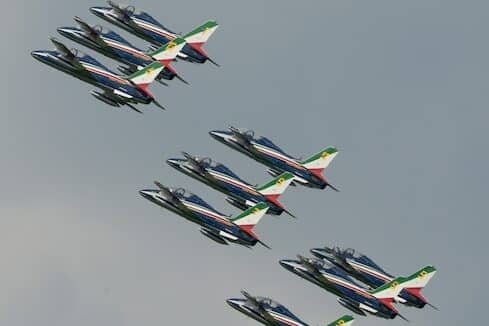
Aermacchi MB-339
The Aermacchi MB-339 is an Italian-built advanced trainer and light attack aircraft designed and manufactured by Aermacchi. Now a part of the Leonardo Aircraft Division. Developed as a successor to the Aermacchi MB-326, the MB-339 serves various roles. This includes advanced training, close air support, and reconnaissance. Its compact, single-engine, tandem-seat design with a low-wing monoplane configuration and retractable tricycle landing gear contributes to its agility and versatility.
Powered by a single Viper 632-43 turbojet engine, the MB-339 boasts modern avionics, including navigation and communication systems. It is capable of carrying a variety of armaments, such as air-to-air and air-to-ground munitions, rockets, bombs, and gun pods. The aircraft has been operated by several air forces worldwide, serving in roles ranging from primary training to light attack and reconnaissance.
Different versions of the MB-339, including the MB-339A, MB-339B, MB-339C, and MB-339CD, offer variations in avionics, equipment, and performance capabilities. Notably, the MB-339 has been chosen by aerobatic display teams, with the “Frecce Tricolori,” the Italian Air Force’s aerobatic demonstration team, using it for many years.
Boeing Model 75 Stearman
The Boeing Model 75 Stearman, developed by the Stearman Aircraft Corporation and later acquired by Boeing. Is a biplane trainer aircraft that gained prominence as a primary trainer during World War II. Featuring an iconic open cockpit design, staggered wings, and a tandem seating configuration. The Stearman became known for its role in training thousands of military pilots.
Originally designed as a civilian trainer, the Stearman had several variants. Including the PT-13 Kaydet, PT-17 Kaydet, and PT-18 Kaydet, used by the U.S. military. It was powered by radial engines such as the Continental R-670 and Lycoming R-680. Serving as a primary trainer, the Stearman played a crucial role in instructing pilots in basic flight maneuvers, aerobatics, and instrument flying.
After World War II, surplus Stearman aircraft entered civilian use, finding popularity in aerobatic flying, crop dusting, and classic biplanes. With over 10,000 units produced, the Boeing Model 75 Stearman remains an iconic and cherished aircraft in aviation history. Many restored examples continue to be flown in airshows and aerobatic displays, reflecting its enduring legacy and timeless appeal.
Consolidated PBY-5A Catalina
The Consolidated PBY-5A Catalina is an American flying boat and amphibious aircraft that played a significant role in maritime patrol and reconnaissance during World War II. Developed by Consolidated Aircraft, the Catalina became one of the most widely used seaplanes of its time.
Here are key details about the PBY-5A Catalina:
The Consolidated PBY-5A Catalina, an American flying boat and amphibious aircraft, played a pivotal role in maritime patrol and reconnaissance during World War II. Developed by Consolidated Aircraft, the Catalina series aimed to create a long-range patrol bomber and reconnaissance aircraft with amphibious capabilities. The PBY-5A featured a twin-engine, high-wing flying boat design equipped with retractable landing gear for both water and land-based operations.
Powered by two Pratt & Whitney R-1830 Twin Wasp radial engines, it boasted a range of over 2,500 miles and a cruising speed of approximately 125 mph. The Catalina’s endurance and versatility made it ideal for various missions, including maritime patrol, anti-submarine warfare, and search and rescue. Armed with defensive weaponry and capable of carrying bombs and depth charges, the PBY-5A played a crucial role in World War II, serving with Allied forces such as the U.S. Navy, RAF, and RAAF.
Uses
Post-war, Catalinas continued their service in roles like search and rescue, firefighting, and civilian transport. Celebrated for its durability and contribution to maritime aviation, many Catalinas have been preserved. Some are still operational, showcasing their legacy in airshows and events.
The Consolidated PBY-5A Catalina’s amphibious capabilities, long-range patrol capabilities, and adaptability made it a versatile and iconic aircraft in the annals of aviation history. Its impact during World War II and its continued service in various roles post-war contribute to its enduring legacy.
The Consolidated PBY-5A Catalina is a versatile World War II-era flying boat designed by Consolidated Aircraft Corporation. Known for its long-range capabilities, the PBY-5A was an amphibious variant equipped with retractable landing gear for water and land operations. It served in roles like patrol bombing, anti-submarine warfare, search and rescue, and transport. With a crew of 8-10, it featured machine guns and depth charges for defence. The Catalina played a critical role in Allied forces. Patrolling maritime routes, and post-war found use in civilian roles like firefighting and surveillance.
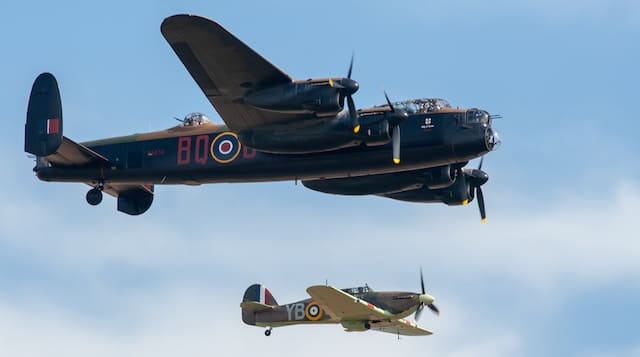
Hawker Hurricane
The Hawker Hurricane is a British single-seat fighter aircraft. That played a crucial role during World War II, particularly in the Battle of Britain. Developed by Hawker Aircraft Ltd, the Hurricane was one of the RAF’s primary fighters in the early stages of the war.
Here are key details about the Hawker Hurricane:
The Hawker Hurricane, a British single-seat fighter aircraft, played a pivotal role during World War II. This was notable in the Battle of Britain and was a primary fighter for the RAF in the war’s early stages. Designed by Sydney Camm in the late 1930s, the Hurricane featured a traditional fabric-covered, semi-monocoque fuselage. It also has a low-wing monoplane configuration and retractable landing gear. Powered by a Rolls-Royce Merlin engine, initially the Merlin II and later variants, the Hurricane boasted reliability and performance. Armed with eight.303-inch Browning machine guns in the wings, later versions incorporated 20mm Hispano cannons.
The Hurricane’s significance was most pronounced in the Battle of Britain. Where it formed the backbone of the RAF’s defence, proving effective against German bombers. Operating in various theatres, including North Africa and the Eastern Front. The Hurricane underwent several variants, each with improvements in structure and armament. With a top speed of around 340 mph and a range of approximately 460 miles, the Hurricane’s agility and stability were notable in dogfights.
Comparable Planes
While often overshadowed by the Supermarine Spitfire. The Hurricane’s ruggedness and adaptability contributed to its longevity in operational roles throughout the war. Although its production waned with the introduction of more advanced aircraft. Some Hurricanes continued to serve in secondary roles and with Allied air forces, solidifying its legacy as a crucial and iconic aircraft in aviation history.
The Hawker Hurricane’s contribution to the defence of Britain and its continued service in diverse theatres make it an important and iconic aircraft in aviation history. Its design and performance characteristics played a key role in the early years of World War II.
Grumman TBF-1C Avenger
The Grumman TBF-1C Avenger, a torpedo bomber, contributed significantly to naval aviation in World War II. Developed by Grumman Aircraft, it featured a crew of three and a powerful Wright R-2600-8 engine. Armed with defensive machine guns and capable of carrying torpedoes, bombs, or depth charges. It excelled in roles like torpedo bombing, level bombing, and anti-submarine warfare. Carrier-based, the TBF-1C variant had a dorsal turret for enhanced defence. Post-war, surplus Avengers served in the Korean War, and its legacy endures as a pivotal naval aircraft.
Curtiss P-40E Warhawk
The Curtiss P-40E Warhawk, also known as “Kittyhawk,” is a notable World War II fighter. Developed in the late 1930s, the P-40E featured a distinctive “shark-nose” design. Powered by an Allison V-1710-39 engine, it was armed with six .50-caliber machine guns and could carry bombs. Serving in various theatres, it gained fame through the Flying Tigers in China. Rugged and durable, the P-40E played a crucial role in early war efforts and continued post-war in various air forces.
Yakovlev Yak-52
The Yakovlev Yak-52, a Soviet-designed aerobatic trainer, succeeded the Yak-50. Developed in the 1970s, it featured a tandem seat, robust design, and aerobatic capabilities. Powered by a Vedeneyev M14P engine, it found use in military training and civilian aviation worldwide. Exported to many countries, its durability and versatility continue to make it a popular choice for training and recreational flying.
Fletcher FU-24
The Fletcher FU-24, a New Zealand agricultural aircraft, was designed in the early 1950s by George H. Toogood. Renowned for its reliability, it excelled in crop dusting and spraying. With a low-wing monoplane design and a radial engine, the FU-24 featured a hopper for chemicals. Making it adaptable for various agricultural tasks. Its rugged construction, adaptability, and export success contributed to its legacy in agricultural aviation.
The de Havilland Vampire, a British jet fighter developed during World War II, made its maiden flight in 1943. With a twin-boom design, straight wings, and a de Havilland Goblin turbojet engine, it entered RAF service in 1945. Versatile, it had variants like the FB.5 for ground attack. Exported globally, it played a role in the Korean War. The Vampire set records and influenced the de Havilland Venom’s development, leaving a lasting legacy in early jet aviation.
Gliders
ULF-1 Ultralight Glider
The ULF-1 Ultralight Glider, designed by Dieter Reich, is a German single-seat glider from the 1980s. Known for its simplicity and portability, it features aluminium tubing and fabric-covered wings. With a glide ratio of 26:1, it excels in aerobatics and is easily disassembled for transport. Popular among DIY enthusiasts, it represents a niche in ultralight glider design.
Cherokee II Glider
The Cherokee II Glider, designed by Chris Heintz, is an American home-built glider. Introduced in the home-built category, it features a steel tube fuselage, wooden wings, and a single-seat configuration. Emphasizing simplicity, it gained popularity among gliding enthusiasts for its ease of construction and enjoyable flying experience. The Cherokee II contributed to the home-built and experimental aviation movement.
Schleicher Ka-6CR Glider
The Schleicher Ka-6CR Glider, a standard-class glider, is a German design from the 1950s. Evolving from the Ka-6 series, it features a T-tail configuration and high aspect ratio wings and is suitable for both club flying and cross-country flights. Recognized for its graceful flying characteristics, it remains popular among gliding enthusiasts.
Slingsby Swallow T-45 Glider
The Slingsby Swallow T-45 Glider, designed by Slingsby Sailplanes Ltd. in the 1960s, is a British high-performance glider. Featuring a steel tube framework, fabric-covered wings, and a single-seat configuration. It offers good performance for both recreational and cross-country soaring. Part of Slingsby’s legacy, it continues to be appreciated by gliding enthusiasts for its sleek design.
De Havilland DH.104 Devon
The de Havilland DH.104 Devon, a twin-engine aircraft, served as a short-haul airliner and military transport. Developed post-World War II, it was related to the de Havilland Dove. The C.1 variant featured a steel tube fuselage, and wooden wings. It accommodated a crew of two and passengers or cargo. Operating in military and civilian roles, it contributed to post-war aviation and remains a part of historical aviation.
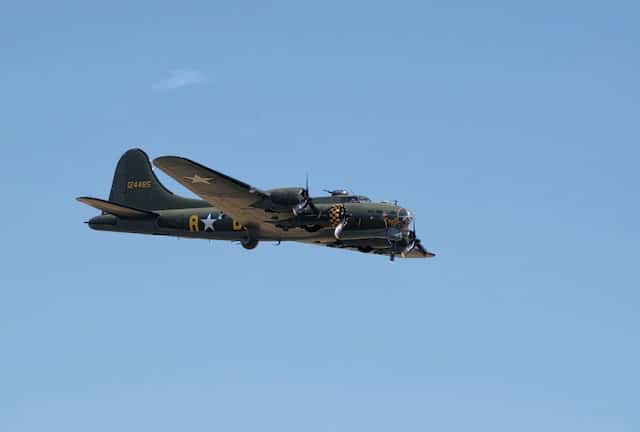
Boeing B-17 Flying Fortress
The Boeing B-17 Flying Fortress, a legendary American heavy bomber from World War II, played a crucial role in strategic bombing campaigns. Developed by Boeing, it featured a distinctive design with four engines, extensive defensive armament, and a large bomb load. Used by the U.S. Eighth Air Force in Europe, it became an enduring symbol of American air power. Rugged and durable, it left an indelible mark on aviation history, with some B-17s still preserved and airworthy today.
Now you know exactly what to expect. So go and enjoy a day at the Mount and in Tauranga, and be sure to pay the Classic Flyers Museum a visit and get a coffee or an ice cream while you’re there.

